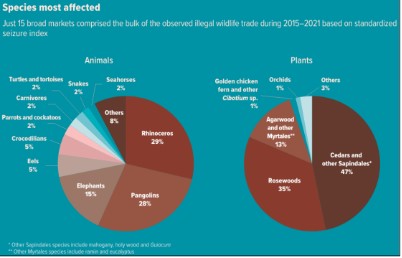Context:
Recently, the United Nations Office on Drugs and Crime (UNODC) launched the 3rd edition of the World Wildlife Crime Report 2024 in Vienna, Austria.
About the Report:
- The World Wildlife Crime Report, probes trends in the illicit trafficking of protected wildlife species.
- This is the third report in a series following the 2020 and 2016 publications.
- The report highlights the trends in the illegal trade in wildlife species listed in the Convention on International Trade in Endangered Species of Wild Fauna and Flora (CITES).
- CITES aim is to ensure that international trade in specimens of wild animals and plants does not threaten the survival of the species.
The United Nations Office on Drugs and Crime (UNODC).
- UNODC was established in 1997 as a result of the merging of the United Nations Centre for International Crime Prevention and the United Nations International Drug Control Programme.
- UNODC works for:
- The United Nations Convention against Transnational Organized Crime and its three protocols (against trafficking in persons, smuggling of migrants and trafficking in firearms).
- The United Nations Convention against Corruption.
- The international drug control conventions.
- UNODC has its headquarters in Vienna, Austria.
Key Highlights of the report:
- The seizure data in the report documents illegal trade in 162 countries and territories during 2015–2021, which impacted around 4,000 plant and animal species—3,250 of which are listed in the CITES Appendices.
- This edition placed new emphasis on the assessment of the causes and impacts of wildlife trafficking and associated crime at a global level.
| Key figures of the Report | ||||
| Key findings | Specific Categories | 1st position | 2nd position | 3rd position |
| Diversity of species recorded in seizures (Percentage share of all seizure records by species group 2015–2021) | Corals 16% | Crocodilians 9% | Elephants 6% | |
| Species most affected | Animals | Rhinoceros 29% | Pangolins 28% | Elephants 15% |
| Plants | Cedars and other Sapindales* 47% | Rosewoods 35% | Agarwood and other Myrtales 13% | |
| Commodities in trade (Top commodities by percentage of seizure records 2015–2021) | Coral pieces 16% | Live specimens 15% | Medicines 10% | |
- According to the report, to bridge knowledge gaps, strong international cooperation, strong coherence, and harmonization throughout the trade chain should be established.
Significance of the report
- World Wildlife Crime Reports are insightful and a powerful tool to inform responses to the devastating consequences of wildlife crime.
- It is an important resource in the work of the International Consortium on Combating Wildlife Crime (ICCWC) and for CITES Parties globally.
- The International Consortium on Combating Wildlife Crime (ICCWC) is the collaborative effort of five inter-governmental organizations to strengthen criminal justice systems.
- It also provides coordinated support at national, regional, and international levels to combat wildlife and forest crime.
Challenges
- Wildlife crime is interconnected with the activities of large and powerful organized crime groups operating in diverse ecosystems from the Amazon to the Golden Triangle.
- Corruption weakens regulation and enforcement, while technology aids traffickers in accessing global markets more efficiently.

